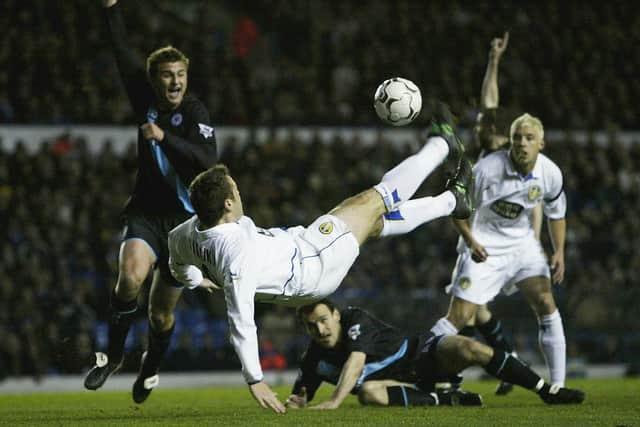Daniel Chapman: Marcelo Bielsa can't sign a Lee Chapman or a Mark Viduka, so what can Leeds United do about goals?


We’ve said this before. Everything about Marcelo Bielsa’s football aims towards them. Even the goalkeeper is chosen for his attacking ability.
While Bielsa is not a 4-4-2 mixer merchant of English football legend, some of his principles are the same: like, get the ball down the other end and score. But that’s the part of the Peacocks’ promotion challenge that isn’t working, week after week, until it’s mystifying how, with so many attacking players creating so many chances, United’s strikers can’t add the finishing touch.
Advertisement
Hide AdAdvertisement
Hide AdREAD: All that ails Leeds United was evident in defeat at CharltonWe’re crying out for an Allan Clarke or a Jermaine Beckford or a Mark Viduka. You could aim any old sort of ball at Viduka in a crowded penalty area, like the one Charlton squeezed upon Leeds on Saturday, and then it was about trust. You could trust him to swivel a defender and shoot where the goalkeeper couldn’t stop it; it was magnificent and eerie, as if with one backheel he could empty a defence.
Viduka came from Australia and signed for big money from Celtic, and there lies a story about Leeds United and strikers. For a club so rightly proud of developing its young players, right back to Dick Ray’s stubborn refusal to enter the transfer market in the late 1920s, Leeds have never produced a top class out-and-out striker to stand alongside a defender like Norman Hunter, or a midfielder like Fabian Delph.
The team that won the FA Cup in 1972 was entirely composed of players Don Revie trained from schoolboys, apart from Jack Charlton, who was trained as a boy at Leeds by Major Frank Buckley; Johnny Giles, who gained a new education when he left Old Trafford for Leeds; and the two strikers who combined to win the cup: Mick Jones’ cross, Allan Clarke’s diving header.
Revie was as reluctant to buy players as Dick Ray or Marcelo Bielsa.
Advertisement
Hide AdAdvertisement
Hide AdBrian Clough spent more on transfers in 44 days than Revie in 13 years. But goals were the one thing his schoolboys couldn’t give him, although Peter Lorimer added plenty from the right wing. Rod Johnson, Jimmy Greenhoff and Rod Belfitt weren’t maturing into the deadly strikers Leeds needed, and Revie had no choice but to spend £100,000 on Mick Jones and £165,000 on Allan Clarke, making two grown-up outsiders part of his family.


It has always been that way. Billy McLeod, the Leeds City sensation, signed from Lincoln. Tom Jennings, still third of United’s top league goalscorers, came for a big fee from Raith Rovers in 1924.
You could argue John Charles, for a while the greatest striker in the world, was homegrown, but he was raised as a centre-half and only became a centre-forward through Buckley’s desperation for goals. Many argued he was better at the back. Terry Connor and Aidan Butterworth burst through from the youth ranks in the early 1980s, but Connor was swapped for Andy Ritchie, and Butterworth decided football wasn’t for him and went to college instead.
After them, only Alan Smith has made it from Thorp Arch to the first team, where his initial blossom was put in the shade by Viduka’s strike rate.
Advertisement
Hide AdAdvertisement
Hide AdNext season Smith was moved to the right wing, and at Old Trafford, converted to midfield. In his last 12 seasons as a player, he scored four. Perhaps there is a genealogy of coaching in Leeds that means its schools and academies will produce any top class footballer you want, as long as you don’t want goals.
Which raises the question of who at Thorp Arch can teach Patrick Bamford, Eddie Nketiah or even Ryan Edmondson, if he can buck the local trends, to do what Lee Chapman used to do.
Slow and ungainly, a child could do more keepie-ups than Chapman; a dog could nutmeg him with a beach ball. But put the ball in the penalty area and he would score. It was that simple, and that difficult, and Howard Wilkinson was lost whenever he was without him. With him, Leeds won promotion and the league.
Bielsa has more in common with Wilkinson than is at first apparent, particularly the belief in getting forward quickly and staying there.
Advertisement
Hide AdAdvertisement
Hide AdBut Wilko had Chappy, who he didn’t have to coach: he just had to put him on the pitch.
Bielsa claims finishing can’t be taught anyway, and United’s record of coaching youngsters to do everything but that bears him out. But we’re down to redundant cries of anguish over here. Bielsa can’t sign a Chapman or a Viduka, but surely there must be something — anything — somebody can do?
Daniel Chapman has co-edited Leeds United fanzine and podcast The Square Ball since 2011, taking it through this season’s 30th anniversary, and seven nominations for the Football Supporters’ Federation Fanzine of the Year award, winning twice. He’s the author of a new history book about the club, ‘100 Years of Leeds United, 1919-2019’, and is on Twitter as MoscowhiteTSB.